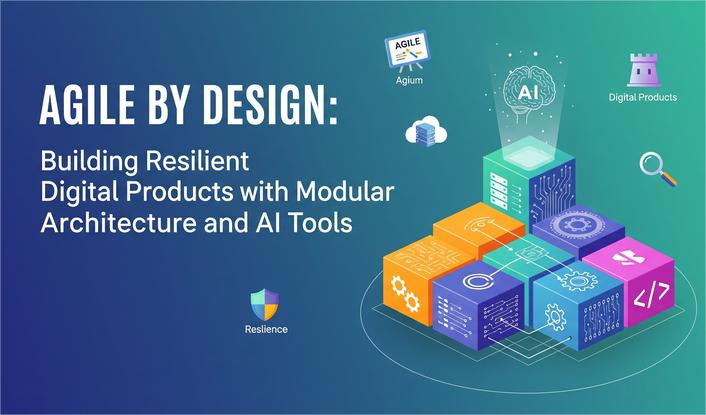
Agile by Design: Building Resilient Digital Products with Modular Architecture and AI Tools
Introduction
The digital landscape is evolving faster than ever. In an age of rapid technological innovation, shifting customer expectations, and constant market disruption, businesses cannot afford to build rigid systems that fail to adapt. The modern customer demands personalized, fast, and secure digital experiences, while businesses face increasing pressure to innovate without sacrificing stability.
This is where the concept of “Agile by Design” comes in. Unlike traditional agile practices that focus mainly on project management, Agile by Design integrates agility into the very foundation of digital products. By leveraging modular architecture and AI-powered tools, businesses can design systems that are flexible, scalable, secure, and future-proof.
In this article, we’ll dive deep into what Agile by Design means, how modular architectures and AI solutions help create resilient digital products, and the best practices companies should adopt in 2025 and beyond.
What Does “Agile by Design” Mean?Agility is no longer just about sprints, stand-ups, or iterative releases. Agile by Design means creating systems, workflows, and products that are built to adapt continuously.
Rather than retrofitting agility after development, businesses ensure that flexibility, modularity, and intelligence are embedded right into the product’s architecture.
Key Principles of Agile by Design-
Adaptability First – The product must evolve with user needs and market shifts.
-
Resilience – Systems should withstand disruptions and recover quickly.
-
Scalability – The product must scale without bottlenecks or technical debt.
-
AI-Enhanced Intelligence – Smart automation and analytics guide continuous improvements.
-
User-Centric Innovation – Every iteration is designed to enhance end-user experiences.
Modular architecture is a design approach where software is broken into independent, loosely coupled modules. Each module performs a specific function and can be developed, updated, or replaced without impacting the entire system.
🔹 Advantages of Modular Architecture-
Flexibility & Speed – Enables faster product updates and feature additions.
-
Resilience – Failures in one component don’t take down the whole system.
-
Parallel Development – Different teams can work on different modules simultaneously.
-
Cost Optimization – Focus resources only where change is needed.
-
Easier Integration – Supports APIs and third-party integrations seamlessly.
-
E-commerce: Payment gateways, recommendation engines, and search functions built as independent modules.
-
FinTech: Fraud detection systems can evolve without impacting the core banking platform.
-
Healthcare: Patient data management modules can integrate with AI diagnostic systems.
-
SaaS Platforms: Subscription, analytics, and user management modules evolve independently.
Artificial Intelligence is not just a productivity booster—it’s the backbone of digital product resilience in 2025. By leveraging AI-powered tools, companies can build systems that are predictive, automated, and self-optimizing.
🔹 AI in Product Development-
Generative AI for Prototyping: AI can generate design prototypes, user flows, and wireframes in minutes.
-
AI-Powered Coding Tools (GitHub Copilot, Tabnine): Assist developers in writing and optimizing code.
-
Automated Testing: AI ensures faster and more reliable quality assurance cycles.
-
Predictive Analytics: Helps anticipate market trends and user behaviors.
-
AI-Powered Personalization: Real-time recommendations improve customer engagement.
-
Anomaly Detection & Cybersecurity: AI identifies threats before they escalate.
-
AI for DevOps (AIOps): Automates monitoring, scaling, and incident response.
-
AI Observability Platforms – Track system health across modular environments.
-
No-Code AI Builders – Empower non-technical teams to contribute to product development.
-
AI in Cloud Cost Optimization – Automates scaling decisions to reduce cloud expenses.
-
Conversational AI – Enhances customer support with natural, human-like interactions.
In a world of cybersecurity risks, regulatory changes, and unpredictable market shifts, resilience is a strategic advantage.
Resilient Digital Products Enable:-
Faster Recovery – Systems bounce back quickly from disruptions.
-
Continuous Innovation – Companies can experiment without fear of failure.
-
Secure Scalability – Growth doesn’t compromise stability or security.
-
Future Readiness – Products adapt to AI, cloud-native, and Web3 transformations.
-
Embrace a Modular-First Strategy – Break monolithic systems into smaller, manageable components.
-
Adopt Cloud-Native Infrastructure – Use Kubernetes, serverless functions, and microservices.
-
Leverage AI Across the Lifecycle – From prototyping to monitoring, AI accelerates agility.
-
Automate Delivery Pipelines (CI/CD) – Enable frequent, safe, and faster deployments.
-
Prioritize Security from the Start – Use AI-enhanced threat detection and compliance tools.
-
Enable Cross-Functional Collaboration – Product managers, AI experts, and engineers must co-create.
-
Focus on Observability & Monitoring – Proactively measure system health with AI-driven insights.
-
Build for Scalability, Not Perfection – Release quickly, then scale based on demand.
The future of digital products lies in adaptability and intelligence. With technologies like AI, cloud-native platforms, and modular architectures, businesses can build products that are:
-
Self-Optimizing – AI monitors and improves systems autonomously.
-
Hyper-Personalized – Products evolve based on user behavior in real time.
-
Secure by Default – AI-driven cybersecurity ensures protection against evolving threats.
-
Sustainable – Modular and AI-optimized systems reduce energy and resource consumption.
By 2030, Agile by Design will become the default approach for organizations worldwide. Those who embed modularity and AI today will lead tomorrow’s digital economy.
Tags :
- Agile by Design
- Modular architecture in software
- AI tools for product development
- Resilient digital products
- Cloud-native modular design
- AIOps and DevOps automation
- Agile product strategy 2025
- AI observability tools
- Building scalable software systems
- Future of agile methodology
- Digital resilience with AI






